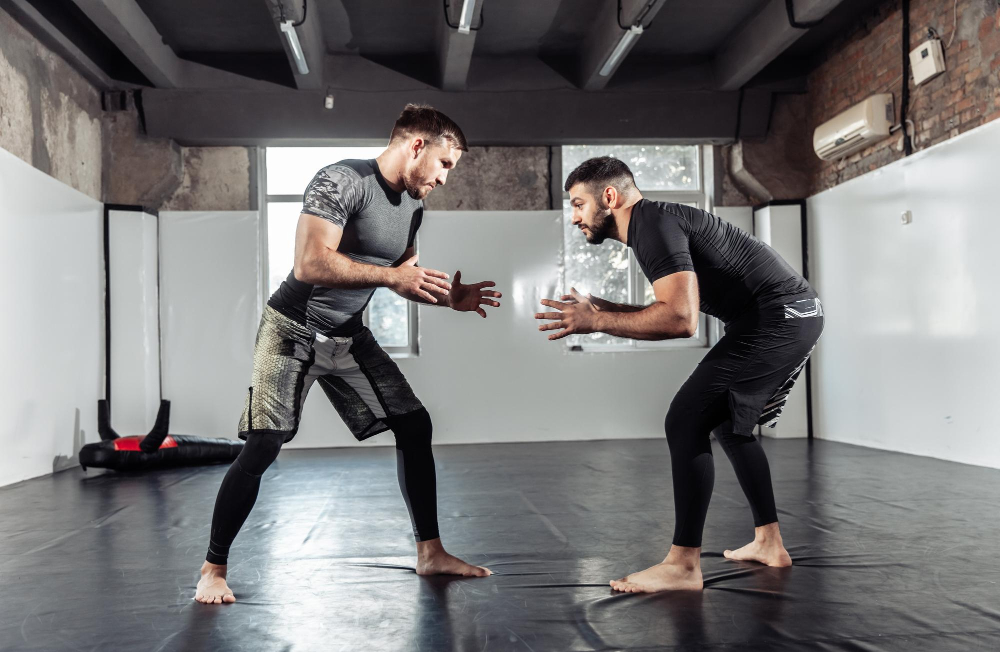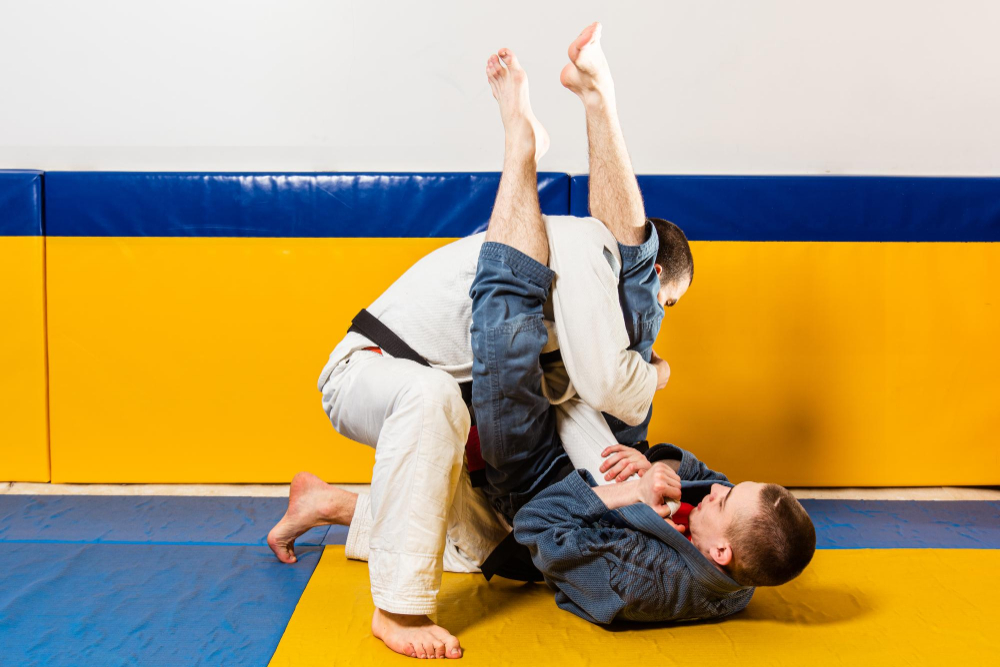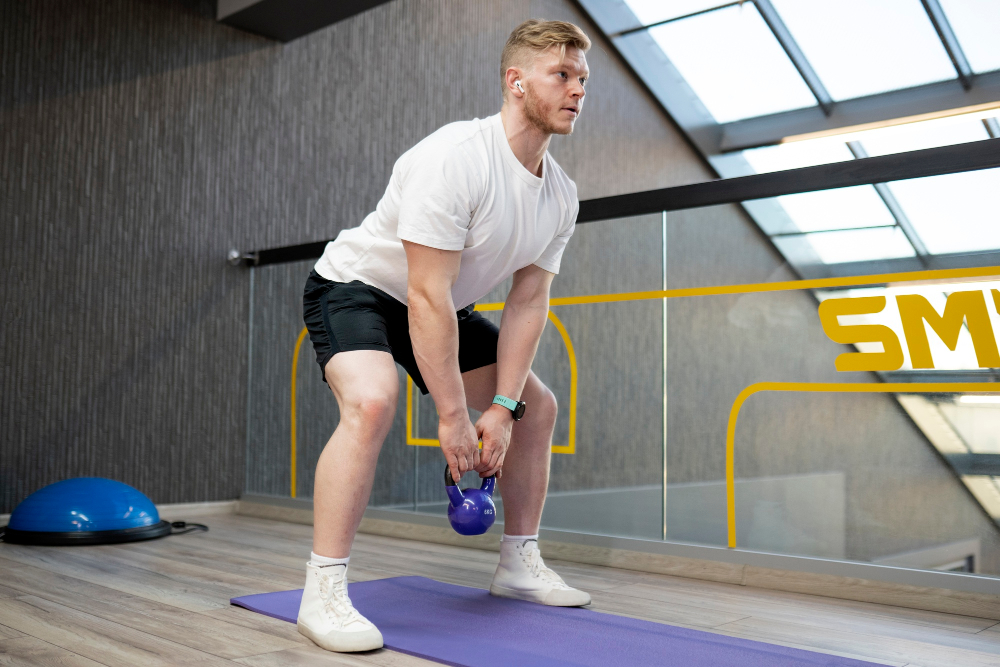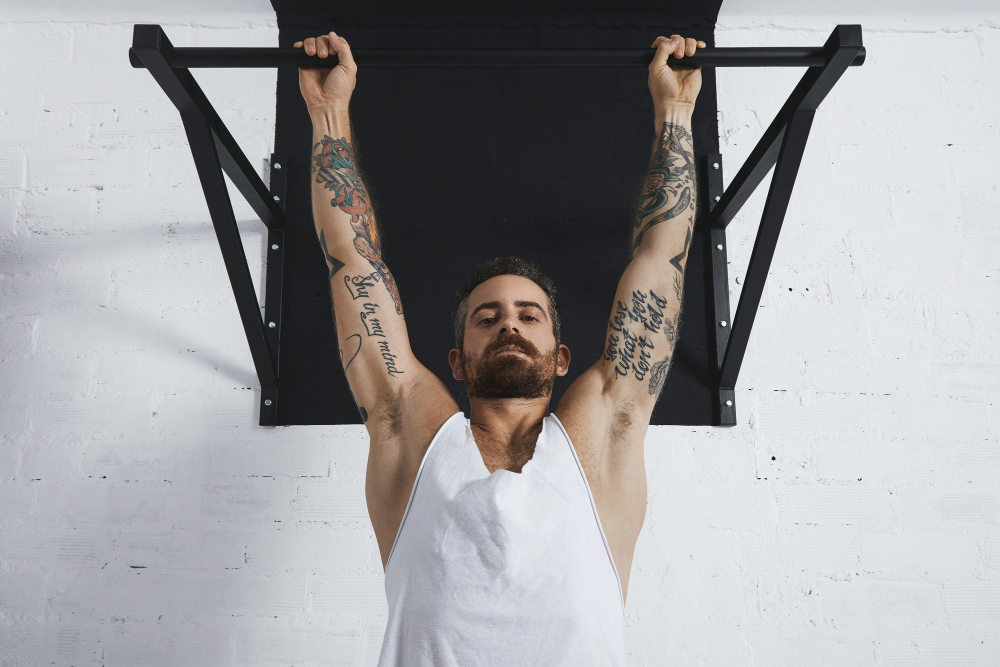BJJ rewards leverage, timing, and problem-solving far more than brute force. Strength matters, but only when it shows up in the exact positions and energy systems that rolling demands. This guide will show you the best exercises for BJJ to build that kind of “mat strength” so you can dominate scrambles, resist fatigue, and stay injury-free.
What Actually Makes You Better at BJJ?
The way you train off the mat should reflect what actually happens on the mat. So here is what you should keep in mind when building a BJJ workout plan.
Technique Beats Absolute Power
A white belt who understands frames will survive against a bodybuilder who does not. Good positions multiply any strength you already have, so technical drilling should always outrank extra barbell work.
The Energy Systems of Rolling
A five-minute round is an interval sport: long isometrics while you hold a guard, explosive bursts during sweeps, and steady aerobic output the entire time. Your program must reflect that mix instead of focusing on a single one-rep max.
3 Beginner Mistakes
- Training Like a Powerlifter: Heavy singles make you stronger on paper, but they don’t help when your grips fail halfway through a round. You need volume and grip endurance, not just raw force.
- Overloading Joints Too Fast: New grapplers don’t have the tissue durability for advanced lifting. Going straight to barbell complexes and heavy pulling is how you end up with elbow pain before you even get your first stripe.
- Forgetting Mobility: Tight hips, tight shoulders, tight everything? You’ll never get into good positions, let alone hold them. Mobility is what keeps you efficient, safe, and dangerous.
Best Exercises for BJJ That Improve Mat Performance
These exercises directly translate to better movement, better control, and better results on the mat.
Hip-Dominant Level Changes
Every bridge, shot, or hip escape starts with your hips. If you can’t hinge cleanly, you’re leaking power and risking injury. These exercises build the engine room for explosive movement.
Kettlebell Swing
- Targets glutes, hamstrings, and hip explosiveness
- Hinge at the hips, swing the bell forward using power from the hips, not the arms. Keep your spine neutral.
- With this exercise, you’ll build the same explosive drive you use for bridging out of mount or initiating a takedown.
Single-Leg Romanian Deadlift
- Improves balance, posterior chain, proprioception
- Stand on one leg, hinge at the hips, and lower with control while the free leg moves behind you.
- This move develops balance and strength for scrambling, base retention, and guard recovery.
Sandbag Good Morning
- Targets lower back endurance, hamstrings, and glutes
- Rest the sandbag across your upper back, push your hips back to hinge forward, then return to standing.
- You’ll reinforce hinge mechanics and build posterior strength for hip escapes and pressure passing.
Rotational Core Control
BJJ is full of twists, torques, and turns. A strong, controlled core lets you move fluidly through sweeps, scrambles, and submissions.
Landmine Rotation
- Targets obliques, rotational power, trunk control
- Anchor one end of a barbell, rotate side to side using your hips and core. Keep arms long but passive.
- This exercise builds torque for throws, sweeps, and turning out of tight spots.
Medicine Ball Scoop Throw
- Improves explosive rotation and hip drive
- Load with your hips and throw the ball into a wall with a scoop motion. Reset fully each rep.
- This move mirrors the explosive twist used in techniques like the tornado sweep or a standing throw.
Ab-Wheel Rollout with Hip Turn
- Targets core stability with rotation
- Perform a normal rollout. At the top of the return, add a slow, controlled hip turn to one side.
- With this move, you teach your core to brace while rotating. Keeps you stable during dynamic movement like shrimping under pressure.
Upper-Body Pulling for Grip Endurance
If your grip fades, your game falls apart. These exercises condition the pulling muscles and grip endurance you need to maintain control deep into rounds.
Gi Pull-Ups
- Targets lats, biceps, and grip endurance
- Wrap a gi or lapel around the pull-up bar and use that to grip. Pull with full control.
- It builds direct strength and endurance for lapel grips, collar chokes, and hand-fighting in the gi.
Rope Climbs
- Improves grip strength, pulling power, and full-body coordination
- Climb a rope using your arms or include your legs for longer reps. Keep your movement clean and tight.
- With this exercise, you’ll build the endurance to keep holding and pulling in scrambles or grip battles.
Ring Rows with Towel Grips
- Targets the forearm and upper-back endurance
- Loop towels over rings or a bar. Perform rows by pulling yourself to the towel while keeping your core tight.
- It mimics no-gi grips and builds the small stabilizers in your hands and forearms.
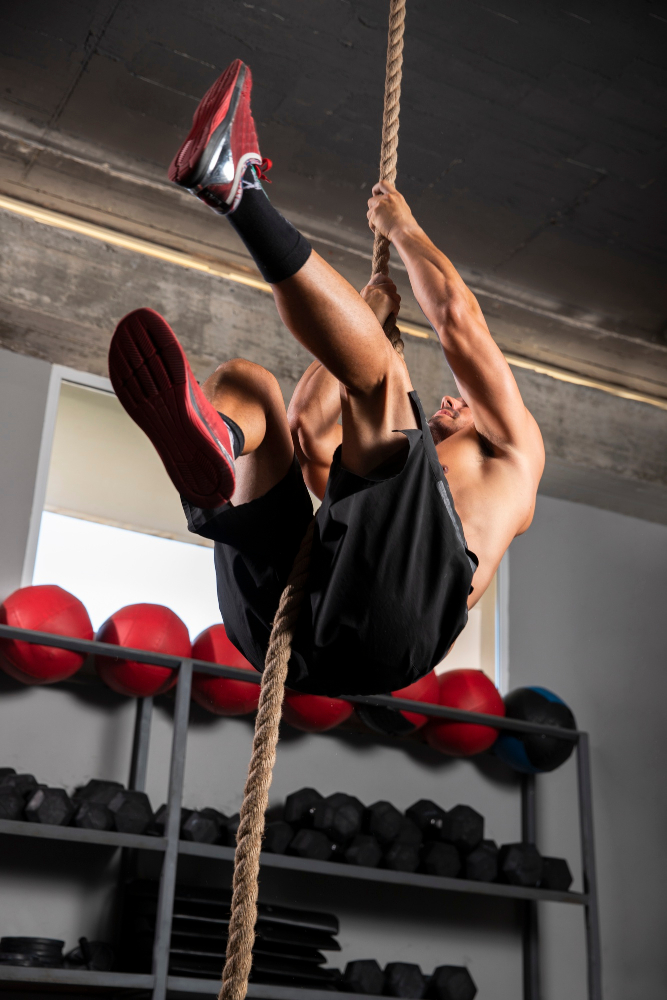
Conditioning That Beats Grip Burnout
Most grapplers gas out because their cardio doesn’t match the pace of live rolling, or their grips fail before their lungs do. Your conditioning should target both. That means aerobic work to stay efficient over rounds, sprint intervals to handle chaos, and grip-focused circuits that actually simulate mat fatigue.
Aerobic Capacity Builders
This is your base. If you can’t recover between scrambles or rounds, you’re playing defense the rest of the night.
- Assault Bike (30 minutes): Ride at a steady pace where you can breathe through your nose the entire time.
- Row Erg Intervals (5×5 minutes): Row hard enough to stay challenged, but controlled enough to recover in the one-minute rest.
- Long Jog with Nasal Breathing: Keep the pace light, only nasal breathing, and aim for 30-45 minutes. Use on rest or low-skill days.
Anaerobic Repeat Sprints
These are for handling scrambles, takedown flurries, and end-of-round surges.
- Prowler Push (30 on / 30 off × 10 rounds): Push heavy but fast. You should hate round 6 and still finish.
- Battle Rope Tabata (8×20 seconds on / 10 off): Go max effort during the 20. Stay still during rest. No pacing.
- Hill Sprint Cluster (6×10 seconds): Sprint up hard, walk back slowly. Full reset between sprints.
Grip Endurance Circuits
You can’t hold positions if your hands give out. This simple circuit trains your ability to hang on when your arms are fried.
Do 3 rounds:
- Gi towel farmer carry (40 meters)
- Plate pinch hold (30 seconds)
- Dead hang from pull-up bar (20 seconds)
- Rest 1 minute between rounds
Mobility and Injury Resilience
Real mobility is control through range, and injury resilience means training the joints, not just the muscles. Here you’ll find a system to keep your body moving well and holding up to the grind.
Daily Joint Prep Flow (10 Minutes)
Start every day or training session with this quick tune-up. It wakes up your nervous system, restores range, and reinforces joint control.
- Neck Nods and Rotations (1×30 seconds each): Move slowly, stay relaxed, and keep range smooth. This will prep your neck for rolls and pressure.
- Scapular CARs (5 reps in each direction): Move only the shoulder blades. Here, you build awareness and control to support frames and postures.
- Hip 90-90 Switches (10 per side): Rotate from hip to hip without using your hands. This move keeps internal and external rotation sharp for guard retention and knee shield work.
Knee and Spine Stability
These movements target the soft-tissue zones that get abused in grappling. They build the small stabilizers that keep your body aligned under tension.
- Banded Tibia Rotation (2×15 each leg): Anchor a band to your mid-foot and rotate the shin in and out.
- Copenhagen Plank (3×20-second holds): Support your top leg on a bench or pad, hold a side plank using your adductors.
- Bird Dog with Band Resistance (3×8 each side): Resist spinal rotation while extending opposite limbs. Use a light band for tension.
Recovery Cool-Down
Don’t skip this. This is where your nervous system resets, your tissues recover, and you prep for your next roll.
- Parasympathetic Breathing (Legs Up Wall): 3×1-minute rounds. Inhale for 4, exhale for 6. Stay still. Let your heart rate drop.
- Foam Rolling (Quads, Lats, Forearms): 2 minutes per area. Don’t rush. Roll slowly and breathe. These are the areas most taxed in grappling.
- Light Stretching (Hip Flexors and Thoracic Spine): Hold each stretch for 30 seconds. Focus on opening, not forcing.
Foundational Exercise List for White and Blue Belts
These bodyweight basics and simple tools build the foundation for everything that comes later.
BJJ Bodyweight Workout
Start here. These movements develop awareness, control, and strength without loading joints too early.
- Hip Bridge: This one is a must-do because it builds glute power for bridging escapes and core bracing for pressure situations.
- Shrimp Variations: By doing this exercise, you create muscle memory for escaping side control and setting up guard retention.
- Hollow Hold: It teaches you to stabilize your core while your hips and legs move, which is exactly what you need when retaining guard.
Simple Equipment Add-Ons
Once your bodyweight control is solid, add these low-skill tools for extra resistance and versatility.
- TRX Inverted Row: Great for building horizontal pulling strength and grip endurance.
- Kettlebell Goblet Squat: You’ll reinforce posture for guard passing and takedown entries.
- Slam Ball Chest Pass: This exercise will improve explosive transfer of force from hips to hands.
Final Thoughts
Raw strength looks impressive in the weight room, but on the mat it is the athlete who blends clean movement patterns, rock-solid grips, and gas-tank conditioning who racks up the taps. Focus on hip hinges, rotational core drills, and grip endurance work, then layer aerobic base and sprint intervals so you can scramble in round three like it is round one.
FAQ
How many strength sessions if I roll five days?
Two full-body lifts are fine. Push to three only if you sleep eight hours nightly and keep rolls technical instead of competition speed.
Should I keep doing a bench press?
Yes, but swap flat barbell for floor press or neutral-grip dumbbells to save shoulders. Press twice per week at most.
What are the best exercises for bad backs or knees?
Stick to landmine variations, single-leg work, hip bridges, and anti-rotation core drills. Avoid heavy bilateral deadlifts until pain-free movement returns.
Image ideas

